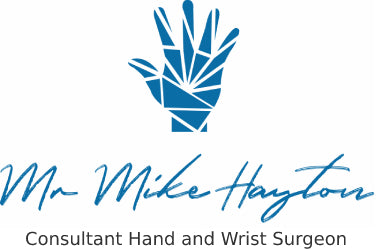Wrist Ganglions
Mr Mike Hayton
FRCS(Trauma and Orth) FFSEM (UK)
Consultant Orthopaedic Hand Surgeon
Other common names
- Dorsal wrist ganglion (back of the wrist)
- Volar wrist ganglion (front of the wrist)
Who does it affect?
Anyone
Why does it occur?
It is a fluid filled sac, that occurs on the back of the wrist (dorsal) or volar (front). The fluid is clear and quite thick. They are thought to be related to changes in the lining of the joint, but not related to arthritis. Occasionally they communicate with the joint and / or a ligament in the joint.
Symptoms
A painless lump that comes and goes in size. The outline is quite smooth and may feel tense like a small ball or balloon (cystic).
Clinical Examination
A ganglion has quite typical features both in its location and appearance. With the lights turned down and a pen torch is shone through the lump, it transilluminates.
Investigations
Usually none. In unusual situations an ultrasound scan will be helpful.
Non-operative treatment
Ganglions can be aspirated under local anaesthetic. A needle is then introduced into the lump and the fluid drained away. I then perform multiple wall perforations to help prevent their reoccurrence. A small pressure bandage is applied for a few days afterwards. Here is a short video clip of a ganglion being aspirated (drained). You will see me infiltrating local anaesthetic under the skin, prior to the aspiration.
At the end of the video you will see me squeeze the fluid out onto the back of my glove.
Operative treatment
If the lump has reappeared 6 weeks after aspiration I usually recommend surgery. The surgery is a day case procedure usually under local or general anaesthetic and takes about 20 minutes. A tourniquet is used; which is like a blood pressure cuff around the upper arm that prevents blood from obscuring the surgeons view.
Local anaesthetic is infiltrated under the skin in line with the incision over the lump. Once numb the skin is incised and then the underlying fat is retracted. Care is taken not to injure nerves and blood vessels. At the base of the wound is the ganglion wall. The ganglion is dissected taking care not to puncture it. The base of the ganglion is identified and excised. The photograph below shows a typical ganglion and also the clear jelly like fluid it contains after I have punctured it. The skin is sutured and a bulky dressing is applied.

Post-operative rehabilitation
The patient is fit to go home soon after the operation. The anaesthetic will wear off after approximately 6 hours. Simple analgesia usually controls the pain and should be started before the anaesthetic has worn off. The hand should be elevated as much as possible for the first 5 days to prevent the hand and fingers swelling. Gently bend and straighten the fingers from day 1. My preference is to remove the dressing at 2 days. The wound is cleaned and redressed with a simple dressing. The sutures are dissolvable and do not need removing.
Return to activities of daily living
It is my advice to keep the wound dry until the wound has healed at 7-10 days.
Return to driving:
The hand needs to have full control of the steering wheel and left hand the gear stick in case of an emergnecy. It is probably advisable to delay returning to driving for at least a few days.
Return to work:
Everyone has different work environments. Return to heavy manual labour should be prevented for approximately 4 - 6 weeks. Early return to heavy work may cause tendons ands nerves to scar into the released ligament. Please ask your surgeon for advice on this.
Complications
Overall, greater than 95% are happy with the result. However complications can occur.
There are complications specific to Wrist Ganglion surgery and also general complications associated with hand surgery.
General complications:
Please click here to view general complications
Specific complications:
Recurrence: This is reported between 10 and 40%. We are not sure whether it is the same ganglion recurring or simply another one forming nearby.
